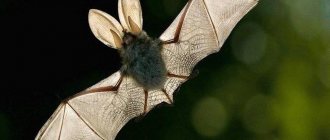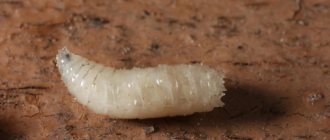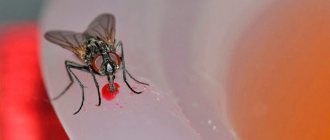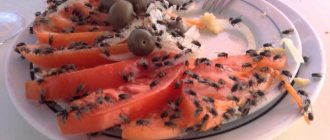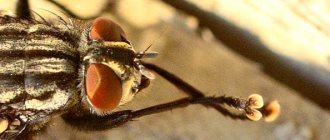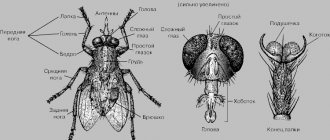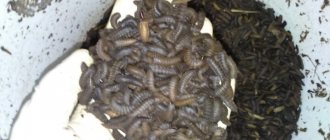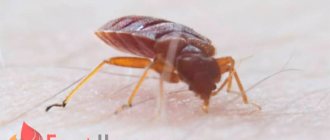Author: sdv
November 16, 2022 08:30
Community: Animals
Tags: interesting animals flies insects planet nature scientists photo
10641
8
Flies have been the most annoying, but perhaps the most popular insects since ancient times. Have you ever thought that ordinary flies do much more than just bother us? Flies play an important role in the process of plant pollination; they are nature’s professional orderlies and an integral part of our lives. Let's find out a little more about them.
What harm do insects cause?
Flies are constantly in contact with an environment in which there are many pathogenic microbes. They fly from garbage dumps into houses and apartments, land on food products, infecting them with worms and bacteria. They carry intestinal infections, helminthic infestations, tuberculosis and many other dangerous diseases. Foods on which flies have crawled cause food poisoning.
In August, with the onset of cold weather, the zhigalka fly flies into homes, which in the summer lives on farms and pastures, where it drinks the blood of animals. This insect bites painfully. She injects poison into the wound, which makes the bite very painful. The zhigalka carries dangerous infections from animals: intestinal diseases, trypanosomes, anthrax.
Eggs and larvae of flies pose a particular danger. When they enter the human body along with food, they do not die, but develop in the internal organs. Maggots can live under the skin, in the intestines, and in the eyes. In medicine, there are cases where larvae entered the human brain and caused death. Therefore, it is important to prevent flies from breeding in homes, and fruits and vegetables brought from the street must be thoroughly washed.
How else are they useful?
There are about 5,000 thousand species of flies in the world, and each of them has its place in the ecological chain. These insects serve as food for birds, fish, amphibians, and spiders and ground beetles feed on them. Maggots are used as fishing bait. There are special farms where fly larvae are bred. Insects are kept in special containers, and animal and fish meat is used as food and habitat. They are left there until the second molt, and then placed in the refrigerator. This is done in order to prevent pupation. The finished product is purchased by fishermen and owners of aquarium fish, frogs and lizards.
Certain species of flies are important as plant pollinators. Some flowers are pollinated only by these insects. To attract them, they emit odors of rotting and carrion, which repel bees and bumblebees, but are liked by flies.
Near flowering plants you can often find hoverflies that look like wasps or bees. These insects bring considerable benefits in gardens and vegetable gardens. They are excellent pollinators, and their larvae eat aphids and psyllids.
Measures to prevent the appearance of house flies
To prevent house flies from appearing in your home, you must always maintain cleanliness and order, especially in areas where food and household waste are stored. During the hot season, take out the trash at least once a day, even if the trash can is not completely filled: due to the heat, the decay process accelerates and different types of flies and midges flock to the odors emitted by rot. Don't leave food uncovered and install mosquito nets on your windows to prevent any insects from disturbing you.
Special caps allow you to protect food from insects, protecting food from dangerous bacteria
Sources
- https://naturae.ru/zhivotnyi-mir/nasekomye/muhi.html
- https://rci76.ru/muhi-i-moshki/chem-polezny-muhi.html
- https://komarmuha.ru/kakuyu-polzu-i-vred-prinosyat-muhi-i-zachem-oni-nuzhny-v-prirode
- https://notklop.ru/muhi/2-fakty/32-zachem-nuzhny-muhi/
- https://klopkan.ru/muhi/vred-i-polza-ot-muh-dlya-chego-oni-nuzhny-v-prirode-i-meditsine/
- https://belt-wrestling.su/muhi-i-moshki/polza-muh.html
- https://zelenplaneta.ru/muhi/vred-i-polza-ot-muh.html
- https://heaclub.ru/kak-proishodit-opylenie-rastenij-kakim-rasteniyam-pomogayut-razmnozhatsya-zhivotnye-i-pticy
[collapse]
Special aroma
Sometimes the answer to the question: “Why do flies land on people?” — lies not at all in body odor, but rather the opposite. The fact is that some aromas that people apply to their bodies in the form of perfumes, eau de toilettes or deodorants turn out to be incredibly attractive to insects.
Of course, this happens extremely rarely with products from well-known brands, since famous manufacturers take care to prevent such a problem. But with perfumes of unknown brands, produced unknown where, how and by whom, this can easily happen.
Brief description of the fly
These insects are small in size - 1-2 cm. Moreover, their body is divided into three parts, densely covered with hairs: the head, abdomen and chest.
On the head there are huge compound eyes and a proboscis (it comes in different types, depending on the type of insect). The thoracic region is rather small, covered with a shield on top. The abdominal section, on the contrary, is quite large, and can even stretch. In general, all flies are very similar in body structure. However, their color and size greatly depend on the type of insect, which, in turn, depends on the conditions and habitat. However, many representatives of this group of animals are dark in color. It often has a green tint. Dark brown colors may also be observed.
Approaching Buddha
Now it has become clear to many why flies like to land. People shouldn't be too concerned about this. Now we can look at this problem from an optimistic point of view and try to find at least something positive. Firstly, insects are part of our wildlife and play a very important role in it. Without them, the planet would simply be mired in the corpses of other insects and animals, as well as in the products of their vital activity. Therefore, it is worth showing a little respect to these creatures for their hard and noble work.
And secondly, annoying buzzing and pestering can be used to your advantage. By trying to come to terms with inconveniences or overcome irritation, a person learns to manage his emotions, control his feelings, be calmer and more peaceful, or, as representatives of some religions say, gets closer to Buddha.
Entomologists' version
According to entomologists, the main reasons why these insects like to land on humans are warmth and food. During flight, insects expend a lot of energy. The same happens during egg laying. In this regard, there is a need for nutrients and protein, which these creatures find on the human body.
Annoying insects are attracted not only by the smell, but also by particles of exfoliated skin, secreted fat or sweat, and salt. The fly carefully examines the human body with its paws (it is on them that the taste buds are located) and, having discovered “deposits” of food, they begin to eat. It dissolves sweat particles and sebaceous secretions with saliva , which contain potassium, calcium, protein and phosphoric acid.
The structural features of the oral apparatus (the insect's mouth is adapted only for the absorption of liquid or jelly food) greatly facilitate the process of absorption of food using the tongue, divided into two separate channels, through each of which food is absorbed.
The second reason for “stickiness,” especially in the morning, is the heat emanating from a person. Cold-blooded insects use external heat sources to warm themselves. They do not have memory and within a few seconds after they have been driven away from their homes, they return to the body again.
Fighting methods
If the fly has already begun to fly, and fruit ripening on late varieties will occur in more than 20 days, the trees can be treated with any of the approved preparations (for example, Arrivo, Karate, Istra, Molniya, Sherpa, Decis, Kinmiks, diluted 1.5 -2 ml of the drug in 10 liters of water).
Spraying is carried out twice, the first time - at the beginning of the mass emergence of insects, when the ground is already sufficiently warmed up, and the thermometer during the day confidently stays above +18 o C.
You can calculate the mass age of the cherry fly:
- According to the flowering of acacia. During this period, it is also useful to spray the ground itself, from which flies emerge after hibernation;
- Using glue traps, purchased or homemade. In the second case, you will need a piece of cardboard covered with bright yellow paper, onto which you will need to apply ALT glue. Traps are hung on cherries and cherries, as soon as more than 20 insects are caught on them, this will signal the beginning of mass summer.
The photo shows an example of a homemade trap for catching various insects
Secondary treatment is carried out 10-15 days after the first spraying. This time it is better to use a different drug to prevent the flies from developing an addiction to a certain active substance. Fruits from trees must be removed immediately after ripening and washed thoroughly before use.
You can try to get rid of flies without using chemicals. To do this, as soon as the cherries have bloomed, you need to take cans or the lower parts of cut plastic bottles, pour a sweet liquid inside (kvass, water with honey, compote, beer) and hang them on the trees, at the rate of 4 cans per tree. The smell of fermented liquid will attract flies, they will stick to the bait and get stuck in it. By periodically changing these traps, you can kill a large number of insects.
If you miss the appearance of the cherry fly ( Rhagoletis cerasi
) in the garden, you can say goodbye to a high-quality cherry harvest. There will be fruits, of course, but with an unpleasant surprise - worms. You don’t really want to eat such berries, which means you need to know which protection for cherries from cherry flies is best for you. Let's try to figure out how to take care of the safety of the garden in advance in order to prevent a massive pest outbreak.
Who pollinates plants?
Pollination of plants is an important stage of reproduction. There are two types of pollination:
- Biological.
- Abiotic.
In the second case, the pollination process is carried out due to weather conditions, or with the help of other plant crops.
Pollination
Pollination of biological plants also comes in several types:
- Artificial pollination. The pollen from the stamens is transferred to the pistil by the person himself.
- Zoophilic pollination. Pollination occurs due to animals. This process can be carried out thanks to hummingbirds, honey plants, and sunbirds. Pollination is also often carried out with the help of rodents, lemurs, and many marsupials.
- Entomophilic pollination. Plants are pollinated by insects. Initially, nature intended the pollination procedure to be much simpler. The pollen itself is sticky and large. There are even flowers that look like a bowl. Almost most plants reproduce using the biological method of pollination.
Insect pollination
Variety of species
In addition to the usual housefly, there are many other types of flies: field flies, fruit flies, dung flies, flies, tsetse flies, silver flies, etc. These insects are distinguished by great diversity in appearance, feeding habits, behavior and degree of danger to people and animals. Based on such diversity of species, the question arises, what are flies for? After all, in nature nothing exists for nothing, but necessarily has some kind of beneficial or harmful effect.
On a note!
According to biological classification, flies belong to the order Diptera, which is divided into several suborders. Their list has been constantly updated over the past 200 years as these interesting insects are studied. Flies have a unique complex structure of eyes, antennae, and mouthparts perform several functions (licking, piercing-sucking and cutting-sucking).
The main diet of flies consists of:
- food waste that remains after a person;
- mucous secretions and excrement excreted by animals and humans;
- blood of mammals;
- vegetable juices.
Flies spend almost their entire lives searching for food, often visiting toilets and contaminated places where rotting animal carcasses or spoiled fruits lie. Then flying into apartments through windows and doors, they land on food and any surfaces in the kitchen and rooms, carrying infection and harmful bacteria on their paws. Therefore, most people consider them carriers of various diseases and dangerous infections.
Is it necessary to fight the pest?
As it turned out, a fly can not only cause harm, but also bring benefit in some cases. Despite this, it is best not to allow the insect into the apartment. If the larva penetrates the body, it can even reach the brain. In this case, only death awaits the person.
There are a huge number of ways to combat the pest. Most often people use:
- traps;
- chemicals;
- folk remedies.
Traps allow you to catch flies of any size. This method of fighting is good because it is safe and you don’t have to worry about children or animals getting hurt. In addition, the trap can be made from available materials, which means you don’t have to overpay.
Chemicals are sold in aerosol form. It is enough to spray the substance around the room, and after 30 minutes the pest will die. The only drawback of this method is that you need to follow safety rules so that family members do not get hurt.
Folk recipes will be useful for those who are in the country or do not trust other options for controlling insects. The good thing about this method is that you don’t need to prepare anything, just pick the herbs and then place them in the room. Tansy, bay leaf or cloves are most often used.
Important: no matter what method is used, dead flies are removed immediately after treating the room.
Application in science and technology
Recently, scientists have become interested in the unique characteristics of flies. Some technical innovations have been created on their basis.
- An American company has created a camera that is structurally similar to the eye of a fly. It consists of more than 1,300 miniature lenses and allows you to take 1,300 shots at a time. The camera is used in computer technology.
- Aeronautical engineers became interested in the structure of flies' halteres. Based on them, fundamentally new devices were created that control the flight of aircraft and missiles. The halteres are small gyroscopes, thanks to which the fly maintains balance in flight and performs “aerobatic maneuvers” that are inaccessible to other insects. These unique organs allow it to adjust its flight when it is knocked down by gusts of wind or swings of a fly swatter.
- Scientists were interested in the unique structure of the ears of flies that parasitize crickets. Hearing aids in the tiny heads of insects make it possible to accurately determine the location of the prey by the sounds it makes. The eardrums are connected by a bridge through which vibrations are transmitted. Thus, the membrane closest to the cricket vibrates more strongly. Scientists believe that studying the structure of a fly's ear will make it possible to improve hearing aids.
Flies are annoying and harmful insects, but you should not dream of their complete extermination. They destroy waste, excrement and animal carcasses. Larvae and adult insects serve as food for birds, fish and amphibians, which would die without them.
Structure
All flies have some morphological characteristics that are similar to each other. The body of an adult is divided into three sections: head, chest and abdomen. The entire body of insects is densely covered with hairs.
Most of the lateral surface of the head is occupied by compound eyes, behind which there are three simple ocelli. Antennae or antennae are attached to the front, above the base of which there is a frontal vesicle. The latter is reduced in some species. The proboscis, the oral apparatus, extends from the lower surface of the head. In most species it is of the licking type. In blood-sucking flies it is of the piercing-sucking or cutting-sucking type.
The thoracic region is represented mainly by the mesothorax. The prothorax and metathorax are very small in size. The upper surface of the mesothorax is called the mesonotum. Its back part is represented by a shield having a triangular shape. On the sides of the chest there are anterior and posterior pairs of thoracic spiracles.
The abdomen of a fly can significantly increase in volume due to stretching of the membranes connecting the abdominal segments. This is important for females with mature eggs and engorged individuals. The abdominal spiracles are located on the abdomen. The last segments of the abdomen are part of the reproductive apparatus - the ovipositor in females and the copulatory apparatus in males. The ovipositor is normally retracted into the abdomen. When eggs are laid or larvae are born, it moves out.
The flies' foot is five-segmented; the last segment contains the organs of touch and taste in the form of pulvillas. The pattern of venation in the wings of flies is an important diagnostic feature.
Most species of flies are oviparous. The eggs are small, oblong in shape. The chorion of the egg is whitish in color, cellular with a dotted sculptural pattern.
Fly larvae are worm-shaped, legless, lacking a separate head, yellowish, less often brownish in color. At the pointed anterior end there are movable mouth hooks that serve for scraping the nutrient substrate and moving the larvae. The larvae are equipped with 2 pairs of spiracles located on the first thoracic segment and on the posterior end of the body.
There are 3 stages of larval development. Moreover, the last, stage III, includes 2 periods - feeding and prepupa. At the end of the prepupal period, the larva molts. The larva of round stitch flies molts without shedding the cuticle, which forms the puparia. When a newborn fly emerges, the puparia opens along a rounded line (hence the name “round sutures”). The larvae of straight-sew flies shed their cuticle during pupation. When the adult insect hatches, the pupal shell is torn in a straight or T-shaped line (hence the name “straight-suture”).
Purpose in nature
Flies cause a lot of trouble for many people, but they play an important role in natural processes. Their larvae can be called natural orderlies who decompose animal corpses and eat rotten fruits, vegetables and feces.
Particularly useful in this regard are blowflies, which are attracted by the smells of decomposition. Many years ago, doctors noticed that maggots that were bred in festering wounds only eat the affected tissues and do not touch healthy ones. The larvae secrete a special antibiotic that stops decomposition and allows them to quietly feed on dead tissue infested with bacteria. This method of cleaning wounds was used during the First World War, then lost its importance due to the development of antibiotics. Today it is again used in many clinics, as certain microorganisms have become resistant to antibiotics.
Scientists have found a use for maggots in agriculture. They process environmentally hazardous waste from livestock and poultry farms. After processing, high-quality fertilizer is obtained, and the fattened larvae become valuable protein food for chickens, cows and pigs.
In China, waste has been disposed of on an industrial scale using flies for many years. This technique gives excellent results at zero cost and does not harm the environment.
Traps
To make protection more effective, traps are used. This method is considered one of the most reliable and effective, partly because the result is extremely clear.
Jars with sugar syrup are used as traps, inside which a cone or a lid made of a plastic bag with several holes is installed. It is this principle that is used in most traps: insects get inside, driven by the sweet smell of sugar, but cannot get out.
Trap tapes are also considered a fairly effective method, although for home use it is better to use homemade rather than professional products. To create such a trap, cardboard strips are covered with thick sugar syrup and hung in places where insects accumulate. Products should be replaced as they become filled with adherent insects.
Read also: Why get a credit card
Reproduction
Reproduction of a housefly
The female becomes sexually mature 24-36 hours after emerging from the pupa. Lays from 70 to 120 eggs per day. The masonry is made in groups or one at a time. The lifespan of an adult is from 8 to 20 days at an air temperature of +20 - +23 degrees Celsius. In some cases, a sexually mature individual lives up to 60 days. During its entire life it manages to give life to at least 6 generations.
Places for laying - rotten vegetables, fruits, plants, food waste, waste, excrement. The egg size is about 1 mm, even if there is a whole clutch, it remains unnoticeable to humans. Development takes 8-50 hours. The larvae are white worms called maggots. The size of individuals of the first generation is about 1 mm.
The larvae that hatch from the eggs live in a semi-liquid medium and feed on the mass in which the female laid her eggs. They eat around the clock and grow quickly. They go through the process of growing up from 3 to 25 days. During this time, they molt three times and increase in size to 13 mm. After three molts, the maggot crawls into a dry, dark place and pupates. After 3 days, the adult appears.
